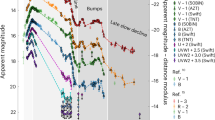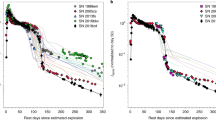Abstract
Type Ia supernovae are thought to be the result of a thermonuclear runaway in carbon/oxygen white dwarfs, but it is uncertain whether the explosion is triggered by accretion from a non-degenerate companion star or by a merger with another white dwarf. Observations of a supernova immediately following the explosion provide unique information on the distribution of ejected material1 and the progenitor system. Models predict2 that the interaction of supernova ejecta with a companion star or circumstellar debris lead to a sudden brightening lasting from hours to days. Here we present data for three supernovae that are likely to be type Ia observed during the Kepler mission3 with a time resolution of 30 minutes. We find no signatures of the supernova ejecta interacting with nearby companions. The lack of observable interaction signatures is consistent with the idea that these three supernovae resulted from the merger of binary white dwarfs or other compact stars such as helium stars.
This is a preview of subscription content, access via your institution
Access options
Subscribe to this journal
Receive 51 print issues and online access
$199.00 per year
only $3.90 per issue
Buy this article
- Purchase on Springer Link
- Instant access to full article PDF
Prices may be subject to local taxes which are calculated during checkout




Similar content being viewed by others
References
Piro, A. L. & Nakar, E. What can we learn from the rising light curves of radioactively powered supernovae. Astrophys. J. 769, 67–79 (2013).
Kasen, D. Seeing the collision of a supernova with its companion star. Astrophys. J. 708, 1025–1031 (2010).
Haas, M. et al. Kepler science operations. Astrophys. J. 713, L115–L119 (2010).
Foley, R. J. et al. Very early ultraviolet and optical observations of the SN Ia supernova 2009ig. Astrophys. J. 744, 38 (2012).
Hachinger, S. et al. The UV/optical spectra of the SN Ia supernova SN 2010jn: a bright supernova with outer layers rich in iron-group elements. Mon. Not. R. Astron. Soc. 429, 2228–2248 (2013).
Nugent, P. et al. Young SN Ia supernova PTF11kly in M101. Astron. Telegr. 3581, 1 (2011).
Nugent, P. E. et al. Supernova SN 2011fe from an exploding carbon-oxygen white dwarf star. Nature 480, 344–347 (2011).
Silverman, J. M. et al. The very young SN Ia supernova 2012cg: discovery and early-time follow-up observations. Astrophys. J. 756, L7–L12 (2012).
Zheng, W. et al. The very young SN Ia supernova 2013dy: discovery, and strong carbon absorption in early-time spectra. Astrophys. J. 778, L15–L20 (2013).
Zheng, W. et al. Estimating the first-light time of the type Ia supernova 2014J in M82. Astrophys. J. 783, L24–L28 (2014).
Hayden, B. T. et al. The rise and fall of SN Ia supernova light curves in the SDSS-II supernova survey. Astrophys. J. 712, 350–366 (2010).
Hayden, B. et al. Single or double degenerate progenitors? searching for shock emission in the SDSS-II type Ia supernovae. Astrophys. J. 722, 1691–1698 (2010).
Bianco, F. B. et al. Constraining SN Ia supernovae progenitors from three years of supernova legacy survey data. Astrophys. J. 741, 20–31 (2011).
Ganeshalingam, M., Li, W. & Filippenko, A. V. The rise-time distribution of nearby type Ia supernovae. Mon. Not. R. Astron. Soc. 416, 2607–2622 (2011).
Tucker, B. E. UV properties of type Ia supernova and their host galaxies. Astrophys. Space Sci. 335, 223–230 (2011).
Jenkins, J. J. et al. Initial characteristics of Kepler long cadence data for detecting transiting planets. Astrophys. J. 713, L120–L125 (2010).
Munari, U. et al. BVRI lightcurves of supernovae SN 2011fe in M101, SN 2012aw in M95, and SN 2012cg in NGC 4424. New Astron. 20, 30–37 (2013).
Sako, M. et al. Photometric type Ia supernova candidates from the three-year SDSS-II SN survey data. Astrophys. J. 738, 162–177 (2011).
Jha, S., Riess, A. G. & Kirshner, R. P. Improved distances to type Ia supernovae with multicolor light-curve shapes: MLCS2k2. Astrophys. J. 659, 122 (2007).
Kessler, R. et al. First-year Sloan Digital Sky Survey-II supernova results: Hubble diagram and cosmological parameters. Astrophys. J. 185 (Suppl.), 32–84 (2009).
Gallagher, J. S. et al. Supernovae in early-type galaxies: directly connecting age and metallicity with type Ia luminosity. Astrophys. J. 685, 752 (2008).
Arnett, W. D. Type I supernovae. I—Analytic solutions for the early part of the light curve. Astrophys. J. 253, 785–797 (1982).
Conley, A. et al. The rise time of type Ia supernovae from the Supernova Legacy Survey. Astron. J. 132, 1707–1713 (2006).
Li, W. et al. Exclusion of a luminous red giant as a companion star to the progenitor of supernova SN 2011fe. Nature 480, 348–350 (2011).
Bloom, J. S. et al. A compact degenerate primary-star progenitor of SN 2011fe. Astrophys. J. 744, L17–L21 (2012).
Brown, T. et al. Kepler Input Catalog: photometric calibration and stellar classification. Astron. J. 142, 112–130 (2011).
Jarrett, T. H. et al. 2MASS Extended Source Catalog: overview and algorithms. Astron. J. 119, 2498–2531 (2000).
Thompson, S. E. et al. Kepler Archive Manualhttp://archive.stsci.edu/kepler/manuals/archive_manual.pdf (5 June 2014).
Kelsall, T. et al. The COBE diffuse infrared background experiment search for the cosmic infrared background. II. Model of the interplanetary dust cloud. Astron. J. 508, 44–73 (1998).
Oke, J. B. et al. The Keck low-resolution imaging spectrometer. Publ. Astron. Soc. Pacif. 107, 375–385 (1995).
Monet, D. et al. The USNO-B Catalog. Astron. J. 125, 984–993 (2003).
Tody, D. Astronomical Data Analysis Software and Systems II (eds Hanisch, R. J., Brissenden, R. J. V. & Barnes, J.), Vol. 52 of Astronomical Society of the Pacific Conference Series, 173–183 (1993).
Acknowledgements
We thank M. Still, M. Fanelli, and S. Gezari for useful conversations, M. Graham, P. Kelly, K. Clubb, and O. Fox for assistance with the observations and reductions of the host-galaxy spectra, D. Scolnic for help with PSNID, and F. Bianco for sending us time series of the companion shock models integrated over the Kepler bandpass. D. Thilker kindly provided the SDSS magnitudes for the supernova host galaxies. R.P.O. and E.J.S. were, in a small part, supported by Kepler GO3 and GO4 grants NNX12AC95G and NNX13AC27G. P.M.G. was partly supported by Kepler grants NNX12AC89G and NNX11AG95G. A.V.F. and B.E.T. were supported by NSF grant AST-1211916, the TABASGO Foundation, and the Christopher R. Redlich Fund. Some of the data presented herein were obtained from the Mikulski Archive for Space Telescopes (MAST). STScI is operated by the Association of Universities for Research in Astronomy, Inc., under NASA contract NAS5-26555. Support for MAST for non-HST data is provided by the NASA Office of Space Science via grant NNX13AC07G and by other grants and contracts. This paper includes data collected by the Kepler mission. Funding for the Kepler mission is provided by the NASA Science Mission directorate. This work is based in part on observations obtained at the Gemini Observatory (program IDs GN-2013A-Q-4 and GS-2013A-Q-115) which is operated by the Association of Universities for Research in Astronomy, Inc., under a cooperative agreement with the NSF on behalf of the Gemini partnership: the National Science Foundation (United States), the National Research Council (Canada), CONICYT (Chile), the Australian Research Council (Australia), Ministério da Ciência, Tecnologia e Inovação (Brazil) and Ministerio de Ciencia, Tecnología e Innovación Productiva (Argentina). Some of the data presented herein were obtained at the W. M. Keck Observatory, which is operated as a scientific partnership among the California Institute of Technology, the University of California, and NASA; the Observatory was made possible by the generous financial support of the W. M. Keck Foundation.
Author information
Authors and Affiliations
Contributions
R.P.O., R.M., and E.J.S. developed the idea of looking for variability in galaxies using Kepler data. R.P.O. selected the target galaxies and created the pipeline to analyse the Kepler data, and developed and implemented most of the innovations in data reduction. The analysis by R.P.O. and E.J.S. of Kepler’s Full Frame Images (not discussed here) convinced us that long-term stability for Kepler data was achievable. E.J.S. has also confirmed the reduction results using independent techniques. P.M.G. modified the MLCS2k2 program to fit Kepler light curves. A.R. used PSNID to classify the supernova. D.K. computed the companion shock models. B.E.T. coordinated, with S.M. and A.V.F., the spectroscopic observations of the host galaxies and measured the redshifts. All authors contributed to the analysis and interpretation of the Kepler supernova lightcurves, as well as the text of this Letter.
Corresponding author
Ethics declarations
Competing interests
The authors declare no competing financial interests.
Extended data figures and tables
Extended Data Figure 1 Confidence regions of fitted parameters.
Two-dimensional projections (contour maps) of the three-dimensional distribution of the fit parameters α, t0, and C. For Kepler supernovae 2012a, 2011b, and 2011c, from top to bottom. a, c, and e show α versus t0, and b, d, and f display α versus C. The contours, from inside to out, contain 25%, 50%, 68.3% (red), 90%, 95.5% (blue), and 99.7% of all 2 × 106 Monte Carlo model-fit results. The dashed red lines are the ±1σ limits of the projections. The vertical cyan line represents the fireball model22. Details of the fitting procedure are described in the Methods section.
Supplementary information
Supplementary Data
This zipped file contains Supplementary Data files and a Supplementary Data guide. (ZIP 720 kb)
Rights and permissions
About this article
Cite this article
Olling, R., Mushotzky, R., Shaya, E. et al. No signature of ejecta interaction with a stellar companion in three type Ia supernovae. Nature 521, 332–335 (2015). https://doi.org/10.1038/nature14455
Received:
Accepted:
Published:
Issue Date:
DOI: https://doi.org/10.1038/nature14455
This article is cited by
-
Infant-phase reddening by surface Fe-peak elements in a normal type Ia supernova
Nature Astronomy (2022)
-
Observational properties of thermonuclear supernovae
Nature Astronomy (2019)
-
No hot and luminous progenitor for Tycho’s supernova
Nature Astronomy (2017)
-
Simulations of stripped core-collapse supernovae in close binaries
Computational Astrophysics and Cosmology (2016)
-
Erratum: No signature of ejecta interaction with a stellar companion in three type Ia supernovae
Nature (2015)
Comments
By submitting a comment you agree to abide by our Terms and Community Guidelines. If you find something abusive or that does not comply with our terms or guidelines please flag it as inappropriate.



